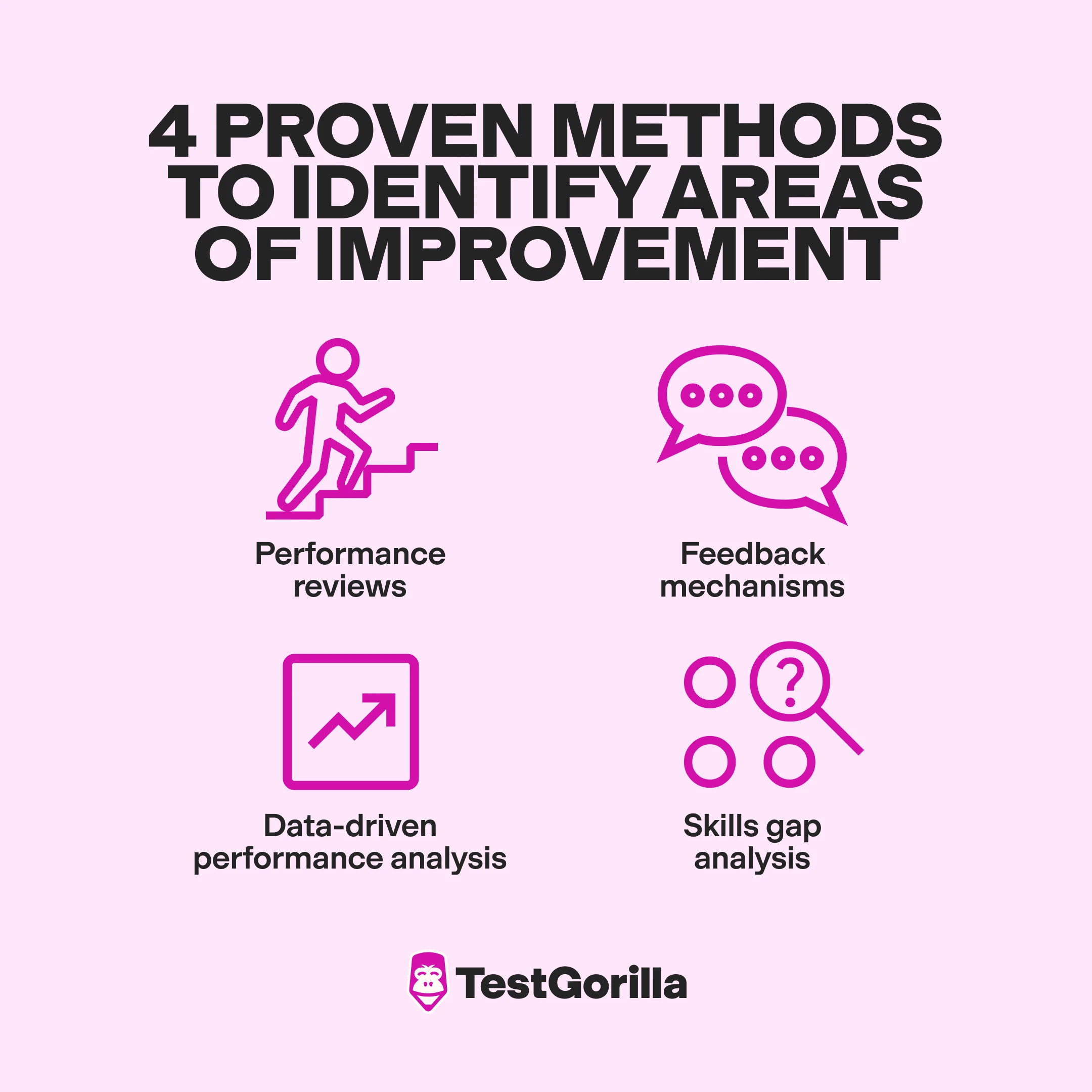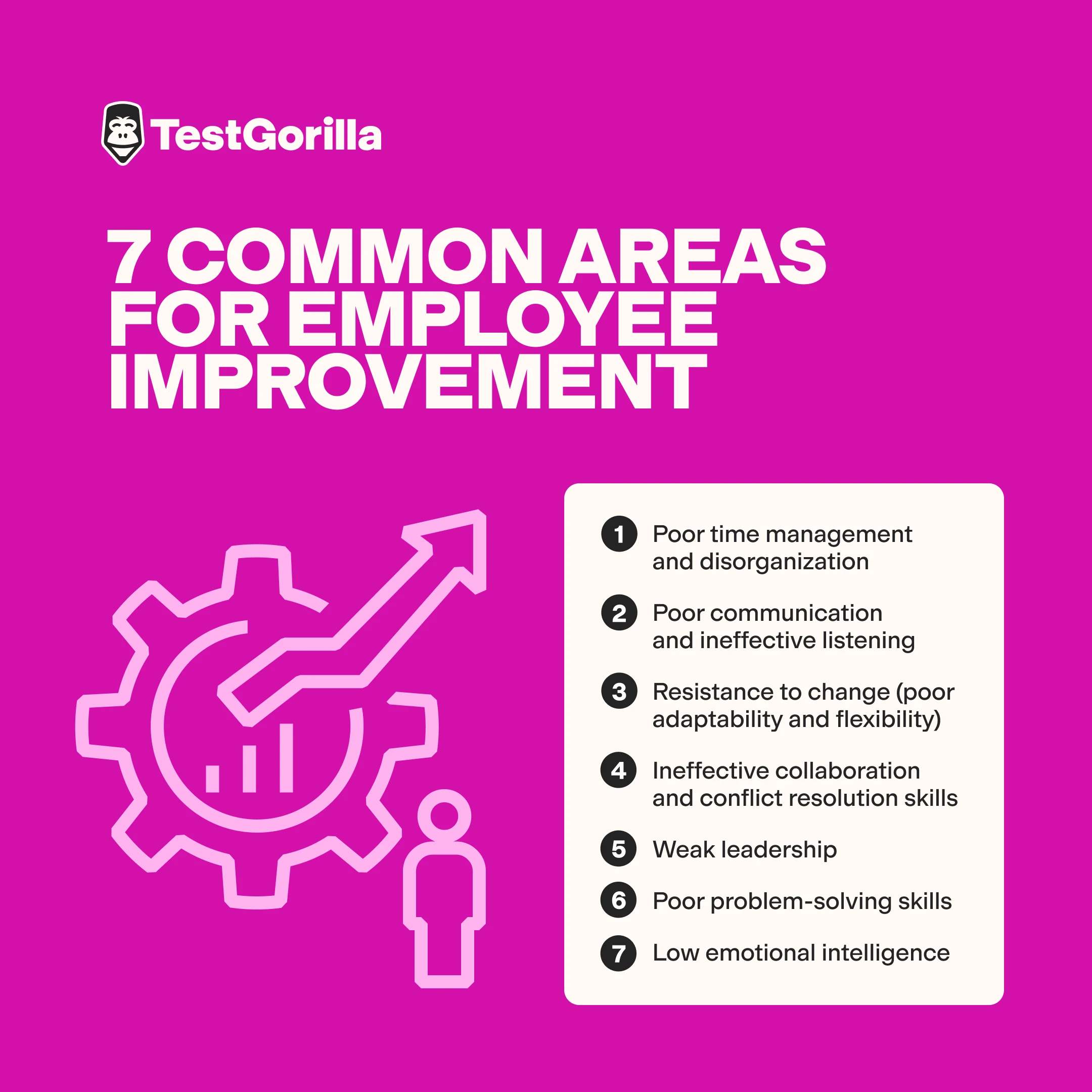Areas of improvement: Identifying and addressing them (plus common examples)
Every business wants a high-performing team, but not every team reaches its full potential. Performance problems can slow down progress, create frustration, and cost money.
By understanding where employees can grow and giving them the right support, companies can help their teams work better, feel more motivated, and achieve more.
In this article, we help you figure out where your team needs to improve and show you straightforward ways to help them.
Key takeaways
Areas of improvement are opportunities to enhance skills and performance, benefitting both individuals and organizations.
Identify these areas through performance reviews, skills assessments, and feedback mechanisms.
Address these areas by setting clear goals, offering the right training, and keeping communication open.
Common areas for improvement include time management, communication skills, adaptability, and teamwork.
Table of contents
- What are areas of improvement?
- Why is professional improvement important?
- How to identify areas of improvement: 4 proven methods
- Effective strategies to address areas of improvement
- Tips to give your employee for addressing their improvement areas
- 7 common areas for employee improvement
- Boost productivity by addressing key improvement needs
- FAQs
What are areas of improvement?
Areas of improvement refer to any skill, behavior, or aspect of performance where there's room to get better.
These can show up in different areas:
Technical skills specific to the job
Soft skills like communication and leadership
Performance metrics like productivity or project completion rates
Interpersonal dynamics within your team
Specific knowledge gaps in your industry
Why is professional improvement important?
Here’s why pinpointing areas of improvement is important:
For HR professionals and L&D specialists: They can create targeted training to ensure employees have all the skills the organization needs to fulfill its strategic objectives.
For managers and team leads: They can guide their teams better with targeted goals, increasing productivity and work quality and improving team dynamics.
For employees seeking growth: They feel more supported, motivated, and confident in their work and can reach their career goals faster, which boosts their morale.
The best insights on HR and recruitment, delivered to your inbox.
Biweekly updates. No spam. Unsubscribe any time.
How to identify areas of improvement: 4 proven methods
Identifying areas for improvement isn't about criticism – it's about growth. You should use systematic methods to understand your employees’ performance. Here are some examples:
1. Performance reviews
Most companies conduct annual or quarterly performance reviews, but the most effective approaches go beyond simple ratings. A comprehensive review should:
Compare actual performance against predetermined goals
Include 360-degree feedback from peers, managers, and sometimes direct reports
Use quantitative metrics and qualitative assessments
Enable self-reflection and employee input
Establish clear, measurable future objectives
For example, part of a performance review might involve you measuring an employee’s sales numbers against pre-set company targets.
2. Feedback mechanisms
Regular and continuous feedback can really help pinpoint areas to improve, often more so than just annual reviews. Effective feedback includes regular one-on-one chats, anonymous surveys for gathering honest feedback, and peer reviews that provide constant insights. It's vital that feedback is clear, practical, and given in a safe, open environment.
For instance, a manager’s check-in with a direct report might reveal a team conflict that’s disrupting performance.
3. Data-driven performance analysis
Using tech and data can help identify exactly where improvements are needed by:
Tracking and analyzing key performance indicators
Comparing team and individual performance to spotlight both high performers and those who need more help
Looking for patterns that show what’s working and what isn’t
For example, to analyze an IT support technician’s performance, you might use analytics from your support ticket software.
4. Skills gap analysis
A skills gap analysis helps figure out which crucial skills your employees need to develop. Start by measuring your employees’ skills against their job requirements and any other skills your organization needs to meet its business goals. This can help you pinpoint skills gaps.
For example, say your business is moving from Google Sheets to Microsoft Excel. You might use a Microsoft Excel skills test to measure employees’ Excel proficiency and see where their skills are lacking.
Pro tip: Check out our guide on how to run a skills gap analysis.
Effective strategies to address areas of improvement
Here are some of the best ways you can address areas for improvement in your organization.
1. Conduct regular performance reviews
Performance reviews and feedback aren't just for spotting problems – they're great for fixing them, too. The key is to use these reviews to set SMART (specific, measurable, achievable, relevant, and time-bound) goals employees can use to guide their performance.
You can also set personal professional development plans outlining these goals.
Even after the official “reviews,” keep up regular chats with your team, using quick catch-ups to talk about how they're doing with their goals and where they can get better.
2. Develop targeted training programs
Based on the areas of improvement identified during assessments, set up or push for training programs that help fill those gaps. This can be anything from learning new tech skills to getting better at talking to people or leading a team.
3. Establish mentorship programs
Pair less experienced employees with mentors who can guide them, give feedback, and offer support. This helps the newer folks get better while also letting the mentors grow their own leadership and coaching skills.
4. Foster a supportive team environment
Promote a workplace where everyone is open and always looking to get better. Celebrate what people do well, give helpful feedback, and keep the lines of communication open.
Tips to give your employee for addressing their improvement areas
Here are some great strategies to share directly with your employees:
Set your own SMART goals.
Regularly seek feedback from supervisors and peers to gain insights into your performance and areas that need improvement.
Self-assess your own work and behavior periodically to self-identify weaknesses or areas for improvement – for example, using reflective journaling or self-assessment questionnaires.
Pursue training and development offered by your employer or seek external courses and workshops, such as those offered by Coursera.
Practice self-discipline and organization with routines, task prioritization, and a structured approach to work.
7 common areas for employee improvement
Here are some areas for improvement commonly seen in work environments, plus tips for addressing them.
Area for improvement | Consequences of not seeking improvement | Tips for improvement |
1. Poor time management and disorganization | Missed deadlines, lower-quality work, and increased stress Example: Someone failing to prioritize tasks and organize information results in critical projects being left incomplete and wasted time searching for info | Use time-blocking strategies to assign specific time slots for tasks and improve focus. Teach prioritization techniques like the Eisenhower Matrix to separate urgent tasks from less critical ones. Incorporate digital tools like calendar apps or task management platforms (e.g., Trello, Asana) to track deadlines and projects efficiently. Establish a consistent filing system for digital and physical documents to save time and reduce clutter. Create a morning planning routine to review tasks, set priorities, and break large projects into smaller, manageable steps. Encourage the Pomodoro Technique (25 minutes of work, 5 minutes of rest) to boost focus and prevent burnout. Set realistic daily goals with buffer time for unexpected delays, helping to maintain a balanced workload. |
2. Poor communication and ineffective listening | Project delays, misunderstandings, and decreased productivity Example: Team members misinterpreting instructions and failing to ask for clarification make errors | Host workshops to enhance both verbal and written communication. Use collaborative platforms like Slack for seamless sharing and communication. Establish regular check-ins to foster clear, ongoing dialogue. Promote feedback practices to ensure understanding and continuous improvement. |
3. Resistance to change (poor adaptability and flexibility) | Can slow down the organization’s ability to adapt and stay competitive Example: Someone’s reluctance to learn new software reduces team efficiency and work quality | Provide training on new tools and technologies. Encourage participation in online courses and workshops. Frame changes as opportunities for growth. Support transitions with resources and clear, open lines of communication. |
4. Ineffective collaboration and conflict resolution skills | Misunderstandings, missed deadlines, and strained relationships Example: A worker frequently interrupts co-workers during meetings, frustrating them | Foster collaboration by organizing team-building activities to strengthen relationships and improve trust. Use tools like Google Workspace or Miro to align projects and ensure clear communication. Celebrate team achievements to boost morale and encourage a positive team culture. Address conflicts early to prevent escalation and keep discussions focused on solutions that benefit everyone. Create a safe and respectful environment where team members feel comfortable sharing their perspectives. Teach employees skills for resolving disputes constructively and, when necessary, involve a neutral third party, such as HR, to mediate complex issues. |
5. Weak leadership | Unclear goals, low motivation, and reduced productivity Example: A leader doesn't give clear directions, and the team doesn’t know what to focus on first | Implement leadership training programs to develop potential leaders, focusing on key skills like decision-making and delegation. Pair emerging leaders with mentors to provide guidance, support, and real-world insights. Offer leadership opportunities by assigning small projects or leading team meetings, helping future leaders build confidence and practical experience. |
6. Poor problem-solving skills | Prolonged issues and inefficiencies within projects Example: A team struggles to identify the root cause of a recurring technical issue and wastes time on temporary fixes | Provide training in problem-solving methodologies like root cause analysis, the Five Whys, or Six Sigma to help employees address challenges systematically. Encourage brainstorming sessions to foster creative and collaborative approaches to problem-solving. Offer simulations or role-playing exercises that allow employees to practice solving complex problems in a risk-free environment. Use decision-making frameworks like the SWOT analysis (Strengths, Weaknesses, Opportunities, Threats) to help employees evaluate options effectively. Assign real-world problem-solving tasks that challenge employees to think critically and apply their skills. |
7. Low emotional intelligence | Conflicts, poor collaboration, and issues with team dynamics Example: An employee who struggles with emotional regulation creates tension within the team | Conduct emotional intelligence workshops where employees can learn to recognize and manage their own emotions and understand those of others. Include role-playing exercises in training to practice empathy and effective conflict resolution, crucial for maintaining a positive work environment. Encourage mindfulness practices like meditation or deep breathing to help employees stay calm and composed under pressure. Use emotional intelligence assessments to help employees gain insights into their strengths and areas for improvement in emotional regulation and empathy. |
Boost productivity by addressing key improvement needs
Boosting workplace performance means pinpointing where your team can improve and providing the right support. Effective strategies include using performance reviews, ongoing feedback, and data-driven analysis to identify and bridge skills gaps and other performance issues.
Performance improvement should start from a new hire’s day one – which is where TestGorilla’s skill assessments come in. You use these to screen your applicants and select ones to interview. Then, after you make your hires, you’ll have valuable data on your new employees’ areas for improvement right from the get-go.
Try TestGorilla today by signing up for our free plan or booking a demo.
FAQs
How do you write areas of improvement in a performance review?
Focus on specific skills or behaviors that need enhancement, such as communication or efficiency. Describe clearly how these areas impact job performance. Offer constructive suggestions for improvement and set achievable goals to help employees track their progress and development.
What are the 3 steps for improvement?
The three steps for improvement are:
Identify - Recognize specific areas where you can enhance skills or performance.
Plan - Develop a clear strategy with actionable steps to address these areas.
Act and evaluate - Implement the plan and regularly assess progress to make necessary adjustments.
You've scrolled this far
Why not try TestGorilla for free, and see what happens when you put skills first.
















